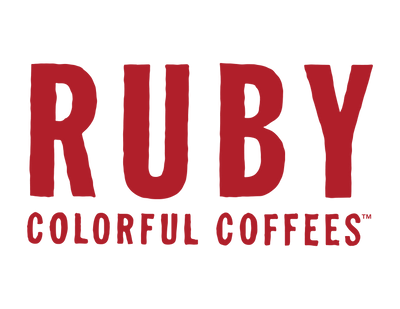One of the first things you see on a Ruby coffee bag are the tasting notes listed on the label. Tasting notes are generally specific flavors that we think represent the overall flavor profile of the coffee. While all of our coffees represent deep sweetness, a round body, and medium roast profile, our main goal is to emphasize the subtle flavors that make coffee or blend unique and to help you find a coffee that fits your preferences.
Coffee is the roasted seed of the coffee fruit, which is grown on short, stubby coffee trees in many parts of the world. Though coffee is indigenous only to Ethiopia, it has been cultivated in other East African countries, Indonesia, Central America, and South America as well. What truly makes coffee unique, however, is the specific climate and soil it's grown in, and which varieties of coffee trees are being grown.
There are hundreds of coffee varieties that are commonly grown, and thousands of climate and soil combinations possible. This means each coffee in our lineup is truly unique. An extremely high elevation grown coffee from a small estate farm in Colombia will develop different flavor characteristics than a coffee grown on a large estate at moderate elevations in Guatemala, and both will be extremely unique compared to a cooperatively processed lot of garden farms in Kenya.
The different flavors we experience are similar to the way apples develop different flavors depending on the variety and where they were grown. Since coffee is also a fruit, part of what makes our coffees taste unique are different combinations of fruit acids and fruit sugars. What makes coffee even more unique, however, is the roasting process.
Roasting the green coffee seeds both triggers the Maillard reaction and creates caramelized sugars. While caramelized sugars create more complex sweetness, the Maillard reaction is creating hundreds of new flavors and aromas with how it changes the different materials in the coffee to begin with.
Roasted coffee contains around 400 flavor compounds and 400 aromatic compounds – that’s about twice as much as wine contains. Because of how complex coffee can be, professional coffee tasters (like the Roasting and QC team at Ruby) try to specifically identify flavors that they are reminded of when they’re tasting a coffee, and narrow down that list to the most commonly identified flavors in order to create our list of tasting notes.
If a member of our team tastes a coffee that has a very bright, citrus acidity that makes their mouth slightly pucker, they might write down “lemon” on their tasting sheet. Another team member might taste the same coffee, but think it reminds them more of lime, or even grapefruit. When we look at all of the tasting notes that have been compiled at the end of the tasting session, the ones that occur most commonly amongst all of the tasters are the ones we feel might be the most common tasting notes a customer might identify with.
Another thing that makes Ruby unique is that we write down all of our tasting notes from drip coffee that we’ve freshly brewed. The main way quality control tastings happen is through a process called “cupping,” where water is poured over coffee grounds in an individual glass and brewed coffee is sipped off the top with a spoon. This process is the best way to evaluate the quality of incoming green coffee samples, or a great way to evaluate the consistency of roast levels week to week, however, we feel that the best way to draft tasting notes that our customers can relate to are the ones we discover in a drip coffee.
Tasting notes aren’t a perfect system for conveying flavor — many coffees showcase their unique flavor profiles in nuanced and subtle ways, so sometimes a tasting note might seem very specific or esoteric. The best way to read tasting notes, however, is to look at all four of them listed and imagine what those four flavors would taste like blended together.
If you see a label that says “toffee, orange peel, golden raisin, dark chocolate,” that coffee might be best imagined as a sort of chocolate and fruit tart dessert. A coffee label that reads “guava, honey, caramel, lime zest” might be best imagined as a sweet fruit-based cocktail.
At the end of the day, tasting notes are there to give you an impression of what a coffee might taste like, but if you find yourself with questions, you can always reach out to us at ruby@rubycoffeeroasters.com, or ask the barista behind the counter to help you find what you’re looking for.
